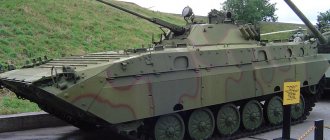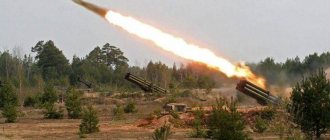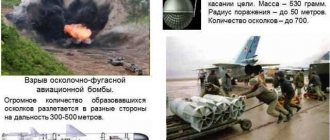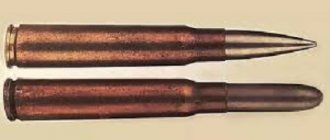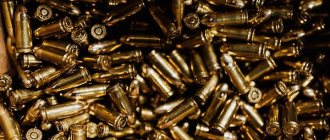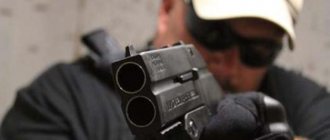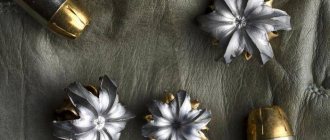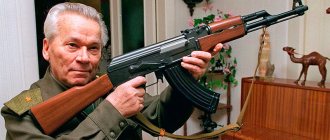Hand and rocket-propelled anti-tank grenades
Hand fragmentation grenades are designed to destroy enemy personnel with shrapnel in close combat (during attacks, in trenches, shelters, populated areas, in the forest, in the mountains, etc.).
Hand grenades RGD-5, RG-42 and RGN are offensive grenades. F-1 and RGO grenades are defensive.
General design of hand-held fragmentation, offensive and defensive grenades
The RGD-5 hand fragmentation grenade is a remote-action grenade designed to destroy enemy personnel in attack and defense. Throwing a grenade is carried out from various positions when operating on foot and in vehicles. The scattering radius of lethal grenade fragments is about 25 m. The average throwing range of a grenade is 40-50 m.
The weight of the equipped grenade is 310 g.
The burning time of the igniter moderator is 3.2-4.2 s.
The RGD-5 hand fragmentation grenade consists of a body with a tube for a fuse, a bursting charge and a fuse.
The F-1 hand fragmentation grenade is a remote-action grenade designed to destroy manpower primarily in defensive combat. You can throw a grenade from various positions and only from behind cover, from an armored personnel carrier or tank (self-propelled guns).
The radius of dispersion of lethal fragments during a grenade explosion is about 200 m. The average throwing range of a grenade is 35-45 m.
The weight of the equipped grenade is 600 g.
The burning time of the retarder is 3.2-4.2 s.
The F-1 hand fragmentation grenade consists of: 1-body; 2 – bursting charge; 3-fuse
The offensive hand grenade RGN and the defensive hand grenade RGO are designed to destroy enemy personnel in offensive and defensive battles, respectively, in various terrain conditions and at any time of the year at ambient temperatures from plus 50 degrees to minus 50 degrees.
RGN and RGO hand grenades consist of : 1 - grenade without a fuse; 2- fuse.
RGN and RGO grenades without a fuse consist of:
1-stopper; 2-cuff; 3-hundred-kan; 4-hemisphere ; 5-explosive mixture; 6-hemisphere; 7- gasket; 8-detonation checker; 9,10 hemispheres.
RKG-3 cumulative hand grenade
The RKG-3 hand-held cumulative grenade is a directional anti-tank grenade designed to combat enemy tanks, self-propelled guns, armored personnel carriers and armored vehicles, as well as to destroy long-term and field defensive structures. Throwing a grenade is carried out from various positions and only from behind cover. The average throw range of a grenade is 15-20 m.
The weight of the loaded grenade is 1070 g.
When a grenade hits a target, it instantly explodes and the resulting stream of gases of high density and temperature penetrates the armor of modern tanks and other durable barriers.
The RKG-3 hand-held anti-tank cumulative grenade consists of: 1—body; 2 - bursting charge; 3 - fuse; 4 - handle
The body of the grenade is cylindrical and serves to house the explosive charge and fuse. The body has: bottom - bottom; inside - a cumulative funnel; on top there is a screw cap with a tube for the igniter. The upper part of the lid ends with a thread for screwing on the handle.
1-cumulative notch;2-shell;3-main charge; 4 – additional charge; 5-tube; 6-thread; 7- cover; 8-cardboard spacer; 9-cumulative funnel.
Procedure for preparing for use
Ammunition for weapons of border shells is stored in equipped magazines, and for weapons of group use - in sealed boxes, in locked drawers or cabinets. The duty officer at the outpost (unit) is responsible for their safety.
An inventory of property is posted in the weapons storage room, which includes the number of pyramids, cabinets, boxes, stands, posters and other property stored in this room. The inventory indicates the cabinet numbers and what seal they are sealed with.
Labels are attached to each pyramid (cabinet, box) indicating the unit, military rank and surname of the person responsible, the number of the pyramid (cabinet, box) and the number of the seal with which they are sealed.
An inventory is posted in the pyramid (cabinet, box) indicating the type and quantity of weapons stored in it. Each nest of the pyramid (cabinet) must have a label pasted on it indicating the type and number of the weapon and gas mask number, as well as the name of the person to whom they are assigned.
All inventories located in the weapons storage room, in pyramids, cabinets, and boxes are signed by the head of the outpost (unit commander).
Arms and ammunition are issued to border guards and accepted from them by the duty officer at the outpost (unit) with registration in the book for issuing weapons and ammunition; all ammunition is recalculated.
All described ammunition, including hand grenades and rounds for anti-tank grenade launchers, is stored in the outpost (unit) warehouse.
It is prohibited to store ammunition near stoves, electric heating devices, etc., or to keep ammunition open in the sun (especially in southern regions).
The weapons of soldiers and sergeants leaving temporarily outside the outpost (unit) for a period of more than 3 days must be handed over to the sergeant major. The surrendered weapons are stored separately from the weapons of the outpost (unit) personnel.
Emphasize to trainees that weapons located in pyramids, storerooms and warehouses must always be unloaded and have the safety on.
Practically prepare your weapon for placement in the pyramid, set it up and order each trainee to perform the same actions with their weapon.
Monitor the correctness of trainees’ actions and correct if necessary.
“The main training and simulation ammunition used in classes and safety measures used when handling them.”
Only specially trained sergeants and soldiers are allowed to use imitation equipment. They must be carefully and specifically instructed.
Training leaders, as well as officers of units (outposts), bear full responsibility for preparing personnel, weapons and simulation equipment for training and exercises.
Loading the machine gun
- attach a loaded magazine to the machine gun, if it was not previously attached to it;
- remove the machine from the safety lock;
- put the translator on the required type of fire;
- vigorously pull the bolt frame back to full strength and release it;
- put the machine on safety if there is no immediate opening of fire or the command “fire” is not followed, and move your right hand to the pistol grip.
If the magazine was not loaded with cartridges before loading the machine gun or the cartridges were used up during shooting, then the magazine must be loaded.
Shop equipment
To equip the magazine, you need to take the magazine in your left hand with the neck up and the convex side to the left, and in your right hand - the cartridges with bullets to the little finger so that the bottom of the cartridge case rises slightly above the thumb and forefinger.
Shop equipment
Equipping the magazine with cartridges from the clip:
1- -store; 2 – adapter; 3 – clip; 4 – cartridges
Holding the magazine with a slight tilt to the left, press the thumb to insert cartridges one at a time under the bends of the side walls with the bottom of the cartridge case towards the rear wall of the magazine.
Loading a magazine from a clip
To equip a magazine with cartridges from a clip, you must: take the magazine (1) in your left hand. With your right hand, attach the adapter (2) to it so that its bends fit into the corresponding grooves on the neck of the magazine; holding the magazine in your left hand, insert the clip (3) with cartridges (4) into the adapter with your right hand, with the cartridges pointing upward with the bullets; pressing the index finger of your right hand on the case body (at the bottom) of the upper cartridge and passing the clip between the middle and index fingers, insert the cartridges into the magazine; remove the empty clip from the adapter, insert a new clip with cartridges and reload the magazine; remove the adapter from the magazine. Using a clip speeds up loading the magazine with cartridges.
Loading the clip with cartridges
To equip the clip with cartridges, insert it into the adapter so that it fits into the grooves of the adapter and rests against its stop (Fig. a).
Loading the clip with cartridges:
a – with adapter; b - without adapter
Holding the clip with the adapter in place in your left hand, with your right hand, holding the cartridge by the bullet and the top of the cartridge case with three fingers (thumb, index and middle), insert it into the grooves of the clip.
The clip can be loaded with cartridges without an adapter; to do this, take the clip in your left hand and the cartridge in your right hand; pressing the spring hook, insert the bullet between the clip and the spring (sink the hook); insert the cartridges into the grooves of the clip (Fig. b); remove the cartridge bullet from under the clip spring.
General information about small arms cartridges.
Types of cartridges
The need to effectively carry out various combat missions assigned to the entire system of small arms requires a wide variety of cartridges used in it, differing from each other, depending on the type of weapon and its purpose, in power and lethality, and as a consequence, in the design of the cartridge as a whole and bullets in particular. Depending on their purpose, ammunition for military small arms is divided into combat and auxiliary. Live ammunition is intended for firing from personal, individual and group small arms with the task of destroying manpower and equipment. Auxiliary cartridges are intended for training in the techniques and rules of operating weapons, simulating shooting, testing the strength of weapons and determining the ballistic characteristics of cartridges and weapons.
Depending on the type of weapon used, there are:
■ pistol cartridges, used for shooting from pistols and submachine guns ■ revolver cartridges, used for shooting from revolvers ■ machine gun cartridges, used for shooting from machine guns, light machine guns and carbines ■ rifle cartridges, used for shooting from hand-held, mounted, single, armored personnel carriers, tank and aircraft machine guns, as well as rifles (including snipers) and carbines; Currently, due to its use mainly in machine guns, this cartridge is often called a rifle-machine gun cartridge. ■large-caliber cartridges used for firing from large-caliber machine guns and large-caliber sniper rifles.
In Russia, the following types of cartridges are in service with various law enforcement agencies:
For military small arms, unitary cartridges are used, in which the component elements are connected into a single whole using a metal sleeve.
Such cartridges consist of four main parts:
■ bullets ■ cartridge cases ■ propellant charge (gunpowder) ■ igniter primer. In addition to unitary cartridges with a sleeve, attempts were made to create caseless cartridges, in which the pressed propellant charge forms a single assembly with a bullet and an igniter primer, without a sleeve. They did not receive distribution.
General structure of bullets
Bullets are the most important part of the cartridge, thrown from the barrel of a weapon when fired. Based on their purpose and nature of action, live ammunition is divided into cartridges with ordinary bullets and cartridges with special bullets.
Cartridges with ordinary bullets are used to destroy open personnel protected by means of personal armor (PIB) or manpower located behind light shelters, as well as unarmored vehicles. Such cartridges are used in all types of small arms, except large-caliber ones. Cartridges with special bullets are designed to destroy military equipment and manpower when a special bullet effect is required - armor-piercing, armor-piercing incendiary, armor-piercing incendiary-tracer, as well as for target designation and fire adjustment. Cartridges with special bullets are used in all types of small arms, except for cartridges for 5.45 mm pistols.
Ordinary bullets
Conventional bullets typically consist of a jacket, a steel core, and a jacket of lead or other ductile materials.
The shell serves to accommodate all the components of the bullet and give the bullet the necessary external shape. It is made of bimetal - hot-rolled low-carbon steel strip, coated on both sides with tombak, consisting of 89-91% copper and 9-11% zinc. Tompak is an anti-corrosion coating, facilitates the manufacture of the shell by stamping and reduces barrel wear. The jacket serves as a plastic base when the bullet cuts into the rifling of the barrel bore and thereby protects the bore from intense wear. The shirt is made from lead or lead-antimony alloys. Antimony is used to increase the lead's hardness and melting point to prevent it from melting when fired. The alloy consists of lead with the addition of 1-2% antimony. Some modern pistol bullets have a jacket made of polyethylene, plastic or aluminum. The jacket of the 12.7 mm BS bullet is also made of aluminum. The core is designed to ensure the bullet's penetrating and lethal effect. It is made of high carbon steel that has undergone heat treatment. Low carbon steel core is used primarily to save lead. The bullet cores of previously produced cartridges were made of lead and its alloys. In connection with the widespread use of body armor and in order to increase the penetrating effect of bullets since 1986. For 5.45 mm cartridges and since 1989 - for 7.62 mm cartridges of the 1943 model and 7.62 mm rifle cartridges, all cartridges with ordinary bullets have sharpened cores made of high-carbon hardened steel. Almost all of these cartridges became armor-piercing. The bullets of special SP-4 pistols do not have a jacket; their rotation is ensured by a driving belt mounted on the splines of the upper cylindrical part of the bullet.
Special bullets
Special bullets are divided into single-action and combined-action bullets. Single-action bullets, depending on the nature of the action, are divided into tracer, armor-piercing, incendiary, explosive, sighting, etc. Recently, combined-action bullets are most often used - armor-piercing tracer, armor-piercing incendiary, armor-piercing incendiary tracer, etc. Tracer bullets
designed to create a visible trace of the bullet's trajectory.
Firing with tracer bullets alternates with firing with ordinary bullets, which is ensured by appropriate equipment in magazines and belts. A tracer bullet
in its device, in addition to the shell and core, has a tracer - a pyrotechnic composition pressed into a cup or directly into the bullet shell, located in the tail of the bullet.
The pyrotechnic composition is a powdery mechanical mixture of flammable substances, oxidizers and some other additives. The tracer lights up from the gases of the powder charge when fired. Incendiary bullets
are designed to ignite a target containing a flammable substance.
An incendiary bullet contains an incendiary composition inside the shell. When hitting a solid barrier that provides sufficient resistance to bullet penetration, as a result of sharp dynamic compression and heating, the incendiary composition ignites, the shell is destroyed, and the flame causes the target containing the flammable substance to ignite. Sighting and incendiary bullets
are designed to facilitate sighting of targets in range and direction, as well as to ignite flammable materials.
A sighting-incendiary bullet has an incendiary composition located in the head of the bullet. When it meets a target, the igniter is triggered, the shell ruptures, forming a visible cloud from the explosion. Armor-piercing incendiary bullets
are designed to destroy targets protected by light armor and personal armor protection, as well as to ignite flammable materials.
The bullet has a bimetallic jacket, a steel core, a lead jacket and an incendiary composition. The penetrating effect of an armor-piercing incendiary bullet is ensured by a core made of hardened high-carbon steel of the VK8 type hard alloy, made from a powdered mixture of tungsten carbide (base) and nickel or cobalt (cementant) by pressing and subsequent sintering at a temperature of about 1500 degrees. Cores made of such an alloy have a large mass and high hardness, which ensures high armor penetration. To ensure the required mass, such bullets have an aluminum jacket. Special instant incendiary bullets (MIB).
Such bullets are used in 12.7 mm and 14.5 mm cartridges. They have increased explosive and incendiary effects and are used mainly to destroy air targets. The action of the bullet is ensured by the presence of an explosive substance in it. When hitting an obstacle, the bullet tip is deformed and causes the detonator capsule to detonate, from which the explosive charge detonates and the bullet casing ruptures, hitting the target. This bullet has a high sensitivity to impact and a shorter response time compared to a conventional incendiary bullet. All special bullets have a mass and shape that ensure the maximum possible alignment of their flight trajectory with the trajectory of conventional ones of the same weapon. This ensures the possibility of using all types of cartridges with both ordinary and special bullets for firing from weapons with the same sighting devices.
General arrangement of sleeves
Cartridge case
performs a number of functions. It is designed to accommodate the powder charge and protect it from external influences, to attach the igniter primer, to attach the bullet, and also to facilitate the sealing of powder gases when fired. In addition, the sleeve ensures a strictly defined, fixed position of the cartridge in the chamber so that the striker strikes the firing pin after loading the weapon exactly on the igniter primer.
Based on the outer outline of the sleeve, the muzzle, body and bottom are distinguished. The bullet is attached to the muzzle of the cartridge case. The transitional conical part of the sleeve between the muzzle and the body is called the sleeve slope. Cases with a slope are called bottle-shaped cases. And without a slope - cylindrical. Previously, there were also conical sleeves. The bottom part of the sleeve may have a flange protruding beyond the sleeve body or an annular groove with a flange that does not protrude beyond the sleeve body. The flange is designed to grip the cartridge when removed from the belt and remove the spent cartridge case or misfired cartridge from the chamber. In addition, the protruding flange serves to secure the cartridge in the chamber. At the end of the bottom part of the sleeve there is a primer socket for placing an igniter primer. The socket is separated from the inner cavity of the cartridge case (charging chamber) by a partition in which there are ignition holes for the passage of a beam of fire from the igniter primer to the powder charge. The hemispherical protrusion in the center of the capsule socket is called the anvil. On her, from a blow with a striker. The percussion capsule composition is undermined. Cartridges that use anvil primers do not have a separate anvil.
According to the method of fixing the cartridge case in the cartridge, there are:
■ with the protruding flange resting on the breech section of the barrel (for 7.62 mm rifle cartridges) or drum (for 7.62 mm revolver cartridges) ■ with the ramp resting against the corresponding chamber cone (5.45 mm cartridges, 7 ,62-mm cartridges of the 1943 model, 12.7-mm and 14.5-mm cartridges) ■ with a cut stop (for cylindrical cartridges) in the ledge of the chamber (9-mm pistol cartridges) The cartridges are currently being manufactured made of bimetal or steel with subsequent varnishing. Previously, sleeves were made of brass. Fastening the bullet to the case is carried out by a tight fit and additional crimping, or by rolling the barrel of the case, or by punching at two or three points. The igniter capsule is placed in the socket with interference fit. If necessary, additional fastening is used by punching the bottom of the sleeve.
Propelling charges
Gunpowder is used as a propellant charge in small arms. They ensure, when the charge burns, that the bullet is given the required flight speed and the operation of the weapon’s automation. The cartridges use both charges made from smokeless pyroxylin powders (plate, tubular with one channel and granular with seven channels) and charges made from nitroglycerin powder with spherical graining.
Primers
The igniter primer is a means of igniting the powder charge. The primer is ignited by the impact of the firing pin (trigger). Therefore, cartridge igniters are called percussion caps. The design of igniter primers for cartridges of various calibers is the same; they differ mainly in size and weight. The design of the igniter primer ensures obturation of the powder gases in the primer socket. The igniter capsule consists of a seamless metal cap into which the impact composition is pressed, which is covered with a circle of tin foil.
This post may contain affiliate links. This means I earn a small commission from links used at no additional cost to you. See my privacy policy for more information.
unique, content, article, weapons, technical specifications, weapons, photo, video
